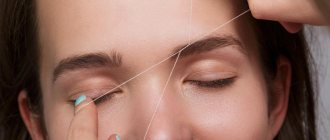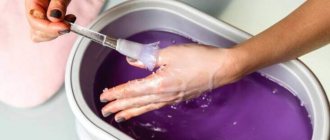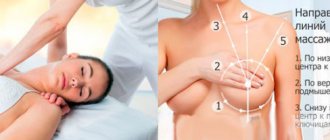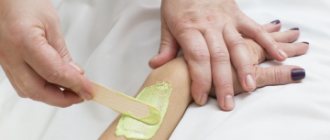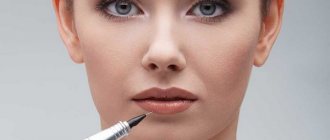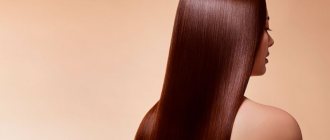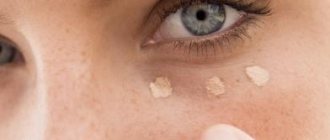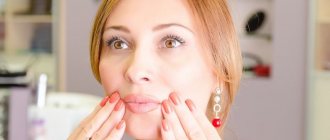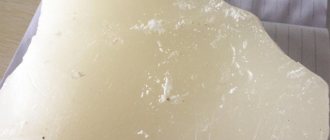Description of the method
The technique is called bandage, because during the work, bandages are used - special strips for hair removal. First, the master lubricates the treatment area with sugar paste, then glues a bandage on top, presses it and removes the strip by the free tip. The strip is easily removed along with the paste and hairs, and with some skill, all the hair is removed at once in one jerk. The bandage technique is radically different from the manual, since the paste is removed not by hand or with small stitches, but immediately in a wide strip using a bandage.
The bandage technique has some similarities to wax hair removal. But if in waxing the hair is removed against the growth, then in sugaring it is the other way around - in the direction of the growth.
What's good about technology?
Advantages of the technique:
- is considered the simplest, many masters recommend that beginners develop sugaring skills with bandages;
- copes well with thin and vellus hair of considerable length;
- hair removal turns out to be of higher quality and more successful the first time;
- makes it possible to treat large areas in a short time;
- causes less pain and is suitable for clients with a low pain threshold.
As with any sugaring technique, the skin remains smooth for 1-3 weeks (depending on the area) and becomes velvety due to light peeling. Under the influence of sugar paste, the hair becomes thinner and lighter, and each time it is removed easier and easier.
In what cases would it be appropriate?
Preference should be given to the bandage technique in the following cases :
- if there are small defects on the skin in the form of scars, stretch marks, small spider veins;
- with an abundance of thin and long vellus hair;
- for thin and sensitive skin;
- for working in heavily sweating areas - thanks to the high speed of work, the body will not have time to sweat;
- for working on hard-to-reach areas (inner thighs, back of shins).
The disadvantage of the master's method is the high consumption of sugar mass and the use of additional consumables - strips.
Sugaring and its types
Sugaring is a hair removal technique using sugar paste. Almost immediately after its appearance, the method became a strong competitor to wax depilation, and there are several reasons for this.
Firstly, this is a more gentle way to get rid of unwanted hair , and secondly, after it, the skin becomes velvety, and the hair slows down , which allows longer breaks between sessions.
Reference. There are two main types of sugar depilation: bandage and manual sugaring techniques.
A more modern method is bandage. The sequence of actions is reminiscent of wax depilation: the sugar mixture is applied using a special spatula, and strips or a bandage for sugaring are applied to it (read what it is and how to replace it in this article).
The second, as the name implies, is carried out without the use of additional devices: hair removal is done manually. This type of depilation is also called classic, as it arose the earliest.
If we compare these techniques, the first one has a number of advantages:
- it can be used on any hair length ;
- it simplifies depilation of hard-to-reach areas ;
- With the bandage technique, sugar paste is consumed more economically .
Thus, the choice of one technique or another depends on individual characteristics, as well as on the length of hair and areas to be depilated. Bandage sugaring is indispensable for varicose veins and stretch marks - for these diseases, classical depilation can cause great harm to health.
Select stripes
The main consumable material of the method (besides the sugar mass) is bandages. They are produced in the form of strips about 7 cm wide and about 20 cm long. One factory package can contain from 10 to 100 products. There are also bandages on sale in rolls up to 100 meters long - a strip of the required length is torn off from a common skein.
Types of bandages
The main criterion when choosing hair removal strips is the material from which they are made. Textile
. They are made from linen or cotton, therefore they are considered an environmentally friendly and hypoallergenic consumable. The good thing about fabric strips is that they can be reused - just wash and dry. But the consumption of paste with such bandages will be greater, since part of the paste will be absorbed into the fabric. The average cost of a package of 100 pieces is about 200 rubles.
Paper
. A budget, but disposable consumable option; paper bandages cannot be reused. For production, non-woven paper with special impregnation is used. The strips do not peel off or get wet, providing good adhesion to the skin. The cost of packaging is from 30 rubles for 10 pieces.
Polymer
. Polymer transparent strips for bandage sugaring techniques are a reusable product. They are easy to wash, and after drying and degreasing they are ready for use again. Due to the tight fit and adhesion to the paste, they ensure painless removal of the smallest hairs. The cost of a package of 50 bandages is 350 rubles.
What to replace at home
If you don’t want to buy a whole package of bandages, or the consumable suddenly runs out, you can find an alternative at home. Replacements can be :
- office printer paper;
- baking parchment;
- pieces of unnecessary cotton or linen fabric - sheets, pillowcases, napkins, thin towels.
The materials will have to be pre-cut into pieces of the required length and width and put to work.
Thin notebook sheets, newspapers and synthetic fabric cannot be used as bandages. They can cause irritation and allergic reactions.
What you will need
To carry out sugaring at home with strips, you will need special products and tools.
Bandage strips
The technique involves the use of bandages - fabric, polymer or paper strips. They are glued to the sugar paste so that the edges or at least one end is free. The strip is grabbed by it and pulled off the body, removing unwanted hairs along with the paste.
It is better to take fabric strips from linen, cotton or other natural materials. The advantage of such strips is that they can be washed, dried, ironed with a hot iron and used again. Polymer strips can also be washed, but paper ones can only be disposable (read more about how bandage strips can be replaced).
Such accessories can be purchased at the store along with the paste, or you can make them yourself.
For example, take a fabric of the appropriate composition, wash it well, iron it and cut strips of the required size.
If you love paper bandage strips for sugaring, the question of what to replace them with is even easier to solve. Regular office paper is suitable for this. It is usually used for small areas in the bikini area, lips, and armpits.
Sugaring paste bandage
There are different types of sugaring paste. For the bandage technique, only soft versions are suitable. But we must take into account that the very soft one has the consistency of almost sugar syrup. Only a professional with good skills can cope with it.
Therefore, the bandage paste for sugaring, which will be used at home, should be of a soft type, but not ultra-soft. As a last resort, you can try a dense one (not hard!), but it is more suitable for manual techniques.
The consistency of the working material should resemble liquid honey .
Therefore, if you overheat the pasta a little, give it time to cool and thicken. Advice ! For a successful procedure, it is important to maintain suitable humidity and temperature in the room. The higher it is, the faster the paste heats up and the more it spreads when used.
Preparing paste for bandage equipment yourself
In order not to make a mistake with the consistency when choosing pasta in the store, you can prepare it yourself. So, if you have chosen the bandage hair removal technique, use the following paste recipe.
Pour 10 tablespoons (without a slide) of granulated sugar, 4 tablespoons of water and half a teaspoon of citric acid into a saucepan with a thick bottom. The latter can be replaced with juice squeezed from half a lemon.
Mix everything well, cover with a lid and place on low heat, stirring occasionally.
First, the product will melt, lighten, then begin to boil and bubble. When it turns a caramel color, slightly darker than light beer, you can remove it from the heat.
It takes approximately 7 minutes to prepare. When the mixture has cooled, try rolling it into a ball. If it doesn’t roll and the paste sticks to your hands, it is undercooked and you need to keep it on the fire a little longer.
Pasta selection
The technique is not “friendly” with all types of sugar pastes. The best adhesion to the hair and bandage is provided by products of ultra-soft, soft and medium consistency. Before use, the paste is heated in a microwave oven, wax melter or in a water bath. The consistency should resemble liquid honey - easy to apply, but not spread over the body. Beginners in sugaring are recommended to start not with homemade pastes, but with factory-made pastes. They are more expensive, but give good results the first time. Which pastes are best for bandage sugaring:
- Diva Cosmetici Sugaring Professional Line, Ultra Soft (Italy) – ultra-soft paste for hair removal of arms, legs and face, copes even with very short hairs (from 1 mm);
- Cannaan, Soft (Israel) – soft paste for bandage and spatula techniques. It has a pleasant caramel aroma and does not leave behind “stumps”;
- Maris, “30” (Russia) – a product of medium consistency with a wide range of operating temperatures (suitable for cool and hot rooms);
- Depiltouch Professional, Soft (China) – designed to meet the needs of sensitive skin, designed to work in delicate areas;
- Aravia Professional Start Epil, Soft (Russia) – copes with hair with a length of 2 mm, thins it and slows down growth.
If you still decide to make caramel for hair removal at home, look for the recipe here.
Required number and frequency of sessions
It is recommended that clients come into the salon at least once every four weeks for the first three months. This will keep the hair in the same growth phase.
But unlike polymer hair removal, the sugaring process can be repeated if necessary after 8-10 days of hair growth. To achieve the best results, order the procedure in a salon when the hair is about 3 millimeters long.
They are in the early stages of growth and will need more time to grow after follicular extraction. In the anagen phase, the procedure leads to permanent hair loss. When they are pulled out at this length, the sugar paste pulls out part of the follicle wall each time, eventually leading to collapse.
Which is better: waxing or sugaring?
Depilation, unlike epilation, is the removal of unwanted hair from various parts of the body through mechanical action.
Frequency of procedures depending on the areas treated:
- upper lip - from 3 to 4 weeks;
- eyebrows - from 2 to 4 weeks;
- armpits – from 3 to 5 weeks:
- neck - 4 weeks;
- hands - from 8 to 10 weeks;
- belly—from 3 to 5 weeks;
- back—from 4 to 6 weeks;
- legs - from 6 to 8 weeks;
- bikini - from 3 to 5 weeks.
Sugaring cartridge
The cartridge is a new product in the field of sugar hair removal, designed to work specifically in the bandage technique. It is a plastic container with a roller applicator. The paste is placed inside the container, which is heated directly in the cartridge before use.
To apply caramel, turn the cartridge over with the roller down and lubricate the epilation area. A strip is placed on top of the sugar layer, and then it is torn off - all according to the classical scheme.
When heating, the cartridge should be in a vertical position - with the roller facing up.
Preparation
High-quality preparation for the bandage depilation procedure is half the success of the entire operation. It is important to follow the sequence of actions and not neglect them.
Peeling
1-2 days before depilation, the skin should be treated with a scrub. This will remove the top layer of keratinized epidermal scales and lift the hair. This preparation will allow the caramel to envelop the hair more tightly, penetrate better into the follicular sac and, accordingly, increase the effectiveness of the procedure.
Anesthesia
To reduce pain, especially when sugaring a deep bikini using the bandage technique, a local anesthetic is applied to the skin 1-1.5 hours before depilation.
Hygiene
The skin is cleaned with a mild detergent without a washcloth, so as not to injure the skin.
Degreasing and disinfection
Hygienic procedures, unfortunately, cannot completely remove residual sebum and bacteria from the surface of the dermal layer. Therefore, before depilation, special cosmetics are applied that can cope with this problem.
Talc treatment
In the absence of specialized talc, you can treat the surface with baby powder. This manipulation will dry out the work area and increase the degree of adhesion of the caramel paste to the hair.
How to prepare for the procedure
An important condition for successful sugaring is absolutely healthy skin in the epilation area. If the area has damage, wounds, scratches, rashes and inflammation, the session will have to be postponed until the skin is completely restored.
Hair length
The bandage sugaring technique is the only one that requires a significant length of hair. In order for the strip of caramel to adhere well, the length of the hair must be at least 3 mm, but not more than 7 mm. The best option is to grow your hair to 5 mm. Although there are soft pastes that can easily cope with even short hair, they are much less common than usual.
Skin preparation
A scrub will help to slightly lift hairs, remove dead skin scales and simplify the hair removal process. On the eve of the procedure, the part of the body with excess hairs is treated with a scrub with small or medium abrasive particles. Do not be too zealous with the scrub so as not to damage the skin, otherwise the procedure will have to be cancelled. Another requirement is impeccable cleanliness of the skin. Use shower gel or mild toilet soap to clean the epilation area. Don’t worry that you will have time to sweat or get dirty before going to the specialist. The specialist will additionally clean the area before applying sugar.
If you do sugaring at home, dry your skin well after water treatments, otherwise the paste will have poor contact with the hairs.
Cautions
Two days before the sugaring procedure, you will have to give up sports training and going to the gym. There is a possibility of chafing or injury to the skin, which will prevent safe hair removal. The day before the “X-hour” you cannot sunbathe – both on the beach and in the solarium. Under the influence of ultraviolet radiation, the skin becomes more sensitive and reacts poorly to sugar hair removal. Contraindications to sugaring:
- first trimester of pregnancy;
- diabetes;
- complicated thrombophlebitis and varicose veins;
- neoplasms and moles on the skin;
- infectious and inflammatory skin lesions.
Preparing consumables
consumables and hair removal products in advance
- paste of soft or medium consistency;
- any type of strips;
- a spatula for scooping and applying caramel;
- heater (wax melter, microwave, water bath);
- wet wipes;
- dry wipes;
- cleansing lotion;
- cosmetic talc or baby powder;
- disinfectant (Chlorhexidine or Miramistin);
- post-epilation lotion with soothing and cooling properties.
It is not recommended to use ethyl alcohol to disinfect skin. It has tanning properties, dries out the skin and complicates the hair removal process.
Possible contraindications
Sugaring is an affordable and very effective procedure that can give a long-lasting feeling of smooth skin. But, despite the long list of advantages, in some cases it is still not worth carrying out the procedure. The master may refuse depilation if:
- There are serious mechanical or bacterial skin lesions (cuts, abrasions, cracks, pustular infections in the inflammatory stage, ulcers).
- Many papillomas, warts or herpes in the area intended for depilation.
- Varicose veins are present (we are not talking about a light vascular network, but about swellings, nodes, swelling, changes in skin color).
- The client has diabetes.
- In late pregnancy.
- With caution in case of epilepsy and cardiovascular diseases.
- There are acute allergic reactions, including to the components included in the paste.
The bandage hair removal technique is convenient for independent use. In this case, you can treat large areas, minimize pain, remove hair even in hard-to-reach places and significantly save time. Of course, it also has its drawbacks - high consumption of paste, in difficult areas you have to work with a smaller area, the need to use spatulas due to the soft consistency of the paste. The bandage technique for self-use is considered more suitable.
Step-by-step instruction
The easiest way to master the technique is on easily accessible and “unpretentious” areas - the legs and thighs. It doesn’t matter whether you epilate yourself or practice on a model. Try sugaring with a bandage technique at home using these instructions . We have selected an example of epilation of the legs using paper strips. 1. Heat the sugar paste and pour it into a small container (you can also leave it in a factory jar).
2. Apply cleansing lotion to the entire area to be epilated using a dry cloth.
3. Move the napkin against the hair growth, as if lifting it. Then apply the disinfectant in the same way.
4. Sprinkle the area with fine talcum powder - it will absorb remaining moisture from the surface of the skin and improve the contact of the caramel.
5. Scoop up a portion of the paste with a spatula and apply a thin layer onto the drumstick using the edge. Lubricate the skin against hair growth, covering a large area at once (no smaller than the size of the bandage).
6. Glue the strip over the paste so that there is a free tip for easy tearing. Smooth the bandage and pull it slightly against the hair growth.
7. Pull the skin with your hand against the hair growth, and with the other, tear off the bandage along the growth with a sharp movement. Try to keep the tear-off path as low and parallel to the skin as possible.
8. Use a damp cloth to remove any remaining paste. Treat your skin with a soothing lotion. It is designed to protect the open mouths of the follicles from bacteria and soothe the skin.
One strip is allowed to be glued and torn off no more than three times, after which it should be replaced with a new one.
Bikini area
As a rule, the bandage technique is not used in the intimate area due to the increased rigidity of the hair. Due to its consistency, a soft paste does not remove very dense hairs well, so the procedure may be unsuccessful. But if you wish, you can perform intimate sugaring in small areas and mini-strips.
When applying each strip, observe the direction of hair growth, since on the pubis they tend to grow chaotically. Applying caramel is allowed only with a spatula - treated metal or disposable. In the first days after intimate sugaring, wear only cotton underwear (slip-on panties without ties), which will not irritate the skin. If you are getting yourself in order before the beach season, plan the session so that it takes place 3-4 days before going to the beach and swimming. During this time, the skin will have time to calm down and the risk of infection will disappear.
Expert opinion
- Cosmetologist
- Surgeon
Anna Avaliani
practicing cosmetologist
In order to be pleased with the results after the procedure, you should follow some rules. Before the session, avoid the solarium and do not sunbathe. Otherwise, you may encounter an inflammatory process after sugaring. Also avoid using fatty creams before the procedure.
Aisha Baron
plastic surgeon
If the procedure was carried out correctly, hairs will begin to appear after 2-3 weeks. Moreover, if you perform sugaring regularly, they become thinner and grow more slowly. But hair grows at different rates on different parts of the body. But hormonal imbalance can change hair growth.
Tips, mistakes, rules
- There will be no bruises on the skin if you remember to tighten it when the bandage comes off.
- If the finished paste is quite liquid, it does not need to be reheated.
- To avoid pigmentation and skin irritation after sugaring, do not sunbathe for 3-4 days after hair removal.
- Remove single hairs remaining after tearing off the bandage with tweezers.
- To care for your skin after sugaring, use lotions of light consistency that will not clog pores.
- To reduce pain, tear off the strip sharply and parallel to the skin.
- In the deep bikini area, the bandage technique is not used - only manual.
- If the strip does not come off but pulls the caramel with it, the paste is too liquid. Try a product of a different consistency or cook a new, thicker portion of the mass. Or perhaps the paste is simply overheated and needs to be cooled.
- After applying the bandage, wait 20-30 seconds for better adhesion before tearing off the strip.
- Do not use wet strips for hair removal or apply several strips to an area at once.
- Before sugaring, carefully examine the skin in the epilated area to determine the direction of hair growth.
- It is forbidden to work with hot paste - it can easily cause burns.
Recommendations after the sugaring procedure
In the first days after the procedure, it is necessary to follow a number of recommendations. For 2-3 days you cannot visit the solarium, swimming pool, sauna, or beach.
Exposure to heat and direct sunlight has a negative impact on the skin and can cause pigmentation. For 2-4 days, shower procedures should be given preference over baths.
If hair removal was carried out in the armpit area, you should not use deodorants for 24 hours. After treating the bikini area, it is recommended to wear underwear made from natural fabrics to prevent irritation.
In order to prevent ingrown hairs, it is necessary to scrub the depilated areas two to three times a week. The skin needs to be regularly moisturized and toned with lotions, creams and serums. It is not advisable to use soap as it dries out the skin.
Bandage sugaring technique: reviews
Sofia, 18 years old
: “With the bandage technique, I completely improvise and simplify.
I cook the paste myself from sugar, lemon juice and water, instead of talcum powder I use regular flour, and instead of bandages I use strips of paper. I apply the mixture with a kitchen spatula, apply the bandage, and after 5-10 seconds I tear it off. You have to apply caramel and the strip to one area no more than twice. The result always makes me happy, although I had to hit the bumps a couple of times to get everything to work out as it should.” Angelina, 31 years old
: “Before learning sugaring myself, I visited many masters and realized that the most painless and comfortable for me was the bandage technique.
I noticed that experienced sugaring specialists use it even in the deep bikini area. I also started my studies with the bandage technique and in most cases I use it.” Elena, 30 years old
: “For a very long time I was afraid to do sugaring on myself, although I was always satisfied with the procedure from the master. I watched enough videos and decided to choose the bandage technique for the first time. The first time everything went wrong - the hairs broke off and were difficult to remove. I realized that I was simply tearing off the bandages incorrectly, too slowly - now everything works out easily.”
Which sugaring pastes are suitable for the face?
Arabia Professional “Honey”
- Advantages: no need to heat, economical in consumption, designed specifically for bandage equipment.
- Price: 1,651 rubles.
This paste can be used to treat even very delicate areas. Please note that the manufacturer advises using it only for banding equipment or diluting denser mixtures, so purchase special strips in advance.
Buy
Arabia Professional "Light"
- Advantages: no need to heat, economical consumption.
- Price: 1,260 rubles.
The paste lives up to its name: most likely, it will not cope with coarse hairs, so there is no point in buying it for bikini sugaring. But it is ideal for mustaches and eyebrows. You can also try it for depilation of arms and other areas where very fine hair grows.
Buy
